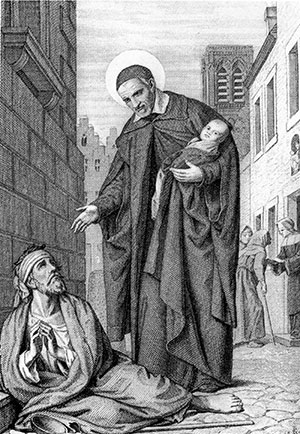Sts. Cosmas and Damian were twins born to Christian parents in Arabia during the third century. They lived in the region around the border between modern-day Turkey and Syria.
Cosmas was a physician and Damian an apothecary, and they both were renowned for their skill, as well as their refusal to charge for their services.
Their charity and Christian witness won many converts to the faith and earned them a place of prominence in the Christian communities of Asia Minor. Therefore, when the persecutions under Roman Emperor Diocletian began in the latter half of the third century, they were some of the first to be sought out for execution.
In 287, they were captured and ordered to deny their faith in Christ. They refused and underwent a series of tortures, including crucifixion, from which, miraculously, they remained unscathed. The torturers, weary of what they realized was the impossible task of forcing apostasy from their mouths, finally beheaded them both. Anthimus, Leontius and Euprepius, their younger brothers, who were inseparable from them throughout life, shared in their martyrdom.
As early as the 4th century, churches dedicated to the twin saints were established at Jerusalem, in Egypt and in Mesopotamia. Devotion to the two saints spread rapidly in both East and West.
They are invoked in the Canon of the Mass and the Litany of Saints. They are regarded as the patrons of physicians and surgeons and are sometimes represented with medical emblems.
— Catholic News Agency, Wikipedia
Feast day: Sept. 27
 On Sept. 27, the Catholic Church remembers St. Vincent de Paul, the 17th century French priest known as the patron of Catholic charities for his apostolic work among the poor and marginalized.
On Sept. 27, the Catholic Church remembers St. Vincent de Paul, the 17th century French priest known as the patron of Catholic charities for his apostolic work among the poor and marginalized.
During a September 2010 Angelus address, then Pope Benedict XVI noted that St. Vincent “keenly perceived the strong contrast between the richest and the poorest of people,” and was “encouraged by the love of Christ” to “organize permanent forms of service” to provide for those in need.
The exact year of Vincent’s birth is not definitively known, but it has been placed between 1576 and 1581. Born to a poor family in southwest France, he showed his intellectual gifts from a young age, studying theology from around age 15. He received ordination as a priest in the year 1600, and worked as a tutor to students in Toulouse.
During a sea voyage in 1605, Vincent was seized by Turkish pirates and sold into slavery. His ordeal of captivity lasted until 1607, during which time the priest converted his owner to the Christian faith and escaped with him from Tunisia. Afterward, he spent time studying in Rome, and – in a striking reversal of fortune – served as an educator and spiritual guide to members of an upper-class French family.
Although Vincent had initially begun his priesthood with the intention of securing a life of leisure for himself, he underwent a change of heart after hearing the confession of a dying peasant. Moved with compassion for the poor, he began undertaking missions and founding institutions to help them both materially and spiritually. The one-time slave also ministered to convicts forced to serve in squalid conditions as rowers aboard galley ships.
Vincent established the Congregation of Priests of the Mission in 1625, as part of an effort to evangelize rural populations and foster vocations to remedy a priest shortage. Not long after this, he worked with the future St. Louise de Marillac to organize the Daughters of Charity, the first congregation of women religious whose consecrated life involved an extensive apostolate among the poor, the sick, and prisoners.
Under Louise’s direction, the order collected donations which Vincent distributed widely among the needy. These contributions went toward homes for abandoned children, a hospice for the elderly, and an immense complex where 40,000 poor people were given lodging and work. He was involved in various ways with all of these works, as well as with efforts to help refugees and to free those sold into slavery in foreign lands.
Though admired for these accomplishments during his lifetime, the priest maintained great personal humility, using his reputation and connections to help the poor and strengthen the Church.
Doctrinally, Vincent was a strong opponent of Jansenism, a theological heresy that denied the universality of God’s love and discouraged reception of the Eucharist. He was also involved in the reform of several religious orders within France.
St. Vincent de Paul died on Sept. 27, 1660, only months after the death of St. Louise de Marillac that previous March. Pope Clement XII canonized him in 1737. In 1835, the French scholar Blessed Frederic Ozanam took him as the inspiration and namesake for the Society of St. Vincent de Paul, a lay Catholic organization working for the relief of the poor.
— Catholic News Agency

